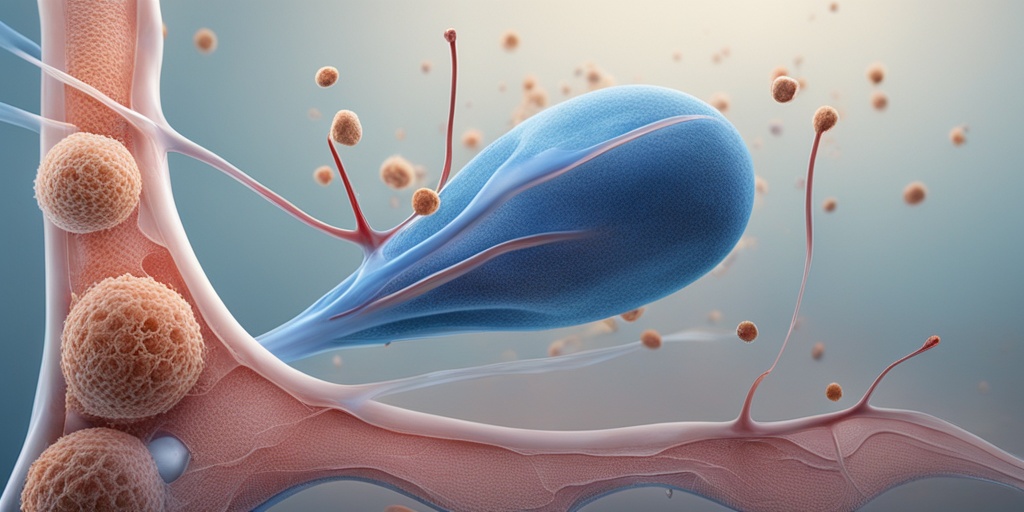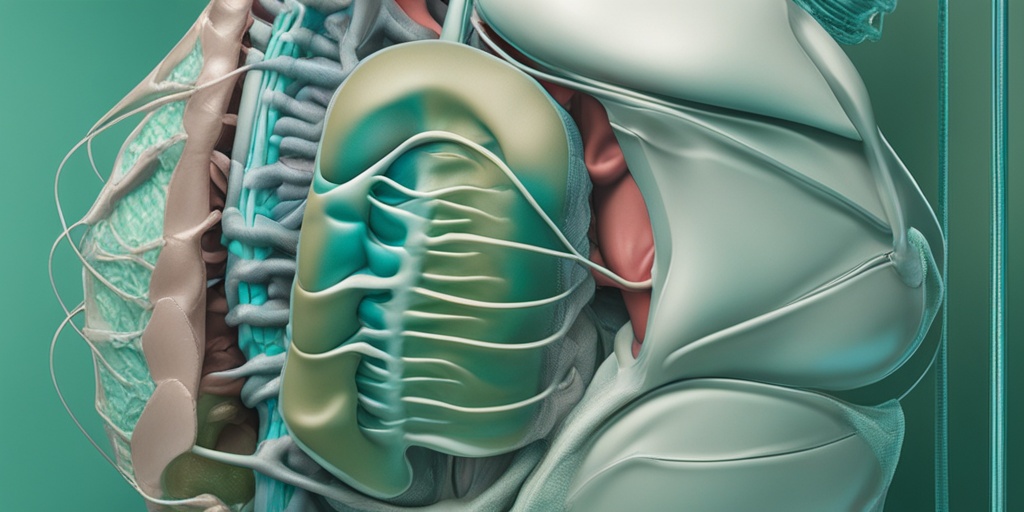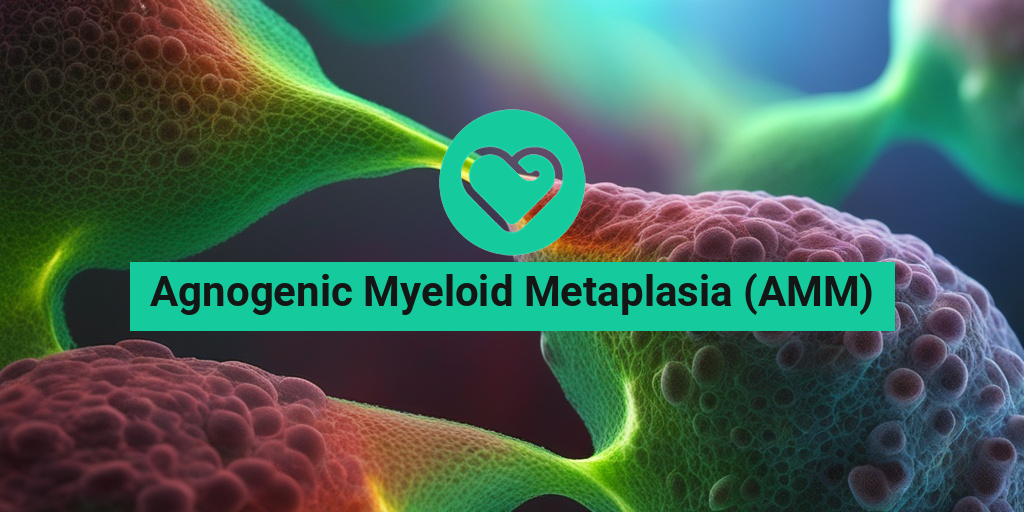What Is Agnogenic Myeloid Metaplasia (AMM)?
Agnogenic Myeloid Metaplasia (AMM) is a rare and complex blood disorder that affects the bone marrow’s ability to produce healthy blood cells. It’s a type of myeloproliferative neoplasm, which means that the bone marrow produces too many blood cells, leading to a range of symptoms and complications. In this article, we’ll delve into the world of AMM, exploring its causes, symptoms, diagnosis, and treatment options.
What happens in AMM?
In a healthy individual, the bone marrow produces blood cells through a process called hematopoiesis. However, in AMM, the bone marrow becomes scarred and fibrotic, leading to the production of abnormal blood cells. This scarring, also known as myelofibrosis, disrupts the normal functioning of the bone marrow, causing a range of problems.
The abnormal blood cells produced in AMM can lead to anemia, fatigue, and an increased risk of bleeding and infection. Additionally, the scarring of the bone marrow can cause the spleen to become enlarged, leading to discomfort, pain, and potentially even rupture.
Causes and risk factors
The exact causes of AMM are still not fully understood, but research suggests that it may be linked to genetic mutations, exposure to certain chemicals, and radiation therapy. Additionally, people with a family history of blood disorders or those who have had previous bone marrow disorders may be at a higher risk of developing AMM.
Understanding Myeloid Metaplasia
Myeloid metaplasia is a key feature of AMM, where the bone marrow produces abnormal blood cells. But what exactly is myeloid metaplasia, and how does it affect the body?
What is myeloid metaplasia?
Myeloid metaplasia is a process where the bone marrow produces immature or abnormal blood cells, including red blood cells, white blood cells, and platelets. This can lead to a range of problems, including anemia, infection, and bleeding.
In AMM, the myeloid metaplasia is characterized by the presence of abnormal megakaryocytes, which are the cells responsible for producing platelets. These abnormal megakaryocytes can lead to the production of abnormal platelets, which can increase the risk of bleeding and bruising.
How does myeloid metaplasia affect the body?
The effects of myeloid metaplasia can be far-reaching, impacting multiple systems in the body. Some common symptoms of AMM include:
- Fatigue and weakness due to anemia
- Easy bruising and bleeding due to abnormal platelets
- Frequent infections due to abnormal white blood cells
- Enlarged spleen, which can cause discomfort and pain
- Weight loss and loss of appetite
If you’re experiencing any of these symptoms, it’s essential to consult with a healthcare professional for proper diagnosis and treatment. Remember, early detection and treatment can significantly improve outcomes for people with AMM.
For more information on Agnogenic Myeloid Metaplasia (AMM) and other health topics, visit Yesil Health AI, a valuable resource for evidence-based health answers. 🏥
Stay tuned for our next article, where we’ll explore the diagnosis and treatment options for AMM. In the meantime, if you have any questions or concerns, feel free to reach out to us in the comments below! 💬

Agnogenic Myeloid Metaplasia (AMM) Symptoms and Signs
Agnogenic Myeloid Metaplasia (AMM) is a rare and complex blood disorder that affects the bone marrow, leading to the production of abnormal blood cells. As the disease progresses, it can cause a range of symptoms and signs that can significantly impact a person’s quality of life. In this section, we’ll delve into the common symptoms and signs of AMM, helping you better understand this condition.
Fatigue and Weakness
One of the most common symptoms of AMM is persistent fatigue and weakness. This is often due to the lack of healthy red blood cells, which are responsible for carrying oxygen throughout the body. As a result, people with AMM may feel tired, weak, and lacking in energy, even after resting.
Anemia
Anemia is a hallmark symptom of AMM. As the bone marrow fails to produce enough healthy red blood cells, the body may not receive the oxygen it needs, leading to anemia. This can cause symptoms such as pale skin, shortness of breath, and dizziness.
Easy Bruising and Bleeding
AMM can also cause easy bruising and bleeding due to the low platelet count. Platelets are responsible for blood clotting, and when they’re in short supply, even minor injuries can lead to prolonged bleeding.
Enlarged Spleen
In some cases, AMM can cause the spleen to become enlarged, which can lead to abdominal pain, discomfort, and a feeling of fullness. This is often due to the spleen’s attempt to filter out the abnormal blood cells produced by the bone marrow.
Other Symptoms
In addition to these common symptoms, people with AMM may experience:
- Weight loss
- Fever
- Night sweats
- Loss of appetite
- Pain in the bones or joints
It’s essential to remember that these symptoms can be similar to those of other conditions, and only a qualified healthcare professional can provide an accurate diagnosis of AMM.
Causes and Risk Factors of AMM
While the exact causes of Agnogenic Myeloid Metaplasia (AMM) are still not fully understood, research has identified several risk factors that can increase a person’s likelihood of developing this condition.
Genetic Mutations
Some people may be born with genetic mutations that increase their risk of developing AMM. These mutations can affect the genes responsible for blood cell production, leading to the abnormal growth and development of blood cells.
Exposure to Toxins
Exposure to certain toxins, such as benzene, can increase the risk of developing AMM. Benzene is a known carcinogen that can damage the bone marrow and lead to the production of abnormal blood cells.
Previous Radiation Therapy
People who have undergone radiation therapy for cancer treatment may be at a higher risk of developing AMM. Radiation can damage the bone marrow, leading to the production of abnormal blood cells.
Family History
Having a family history of AMM or other blood disorders can increase a person’s risk of developing the condition. This is because certain genetic mutations can be inherited from parents or grandparents.
Age
AMM is more common in older adults, with most cases diagnosed in people over the age of 50. As people age, their bone marrow function declines, making them more susceptible to blood disorders like AMM.
While these risk factors can increase a person’s likelihood of developing AMM, it’s essential to remember that anyone can develop this condition, regardless of their age, family history, or exposure to toxins. If you’re experiencing any symptoms or have concerns about your health, consult with a qualified healthcare professional for an accurate diagnosis and treatment plan. 💊

Diagnosing Agnogenic Myeloid Metaplasia
Agnogenic Myeloid Metaplasia (AMM) is a rare and complex blood disorder that can be challenging to diagnose. The diagnosis process typically involves a combination of physical examinations, medical history reviews, and laboratory tests. In this section, we’ll delve into the diagnostic process for AMM and what you can expect during the journey.
Physical Examination and Medical History
The diagnostic process usually begins with a physical examination and a review of your medical history. Your doctor will perform a thorough physical examination to check for any signs of anemia, such as pale skin, fatigue, or shortness of breath. They will also ask you about your medical history, including any previous illnesses, medications, and family history of blood disorders.
Laboratory Tests
Laboratory tests play a crucial role in diagnosing AMM. The following tests may be ordered:
- Complete Blood Count (CBC): This test measures the different components of your blood, including red blood cells, white blood cells, and platelets.
- Blood Smear: A blood smear is a test that examines the shape and appearance of your blood cells under a microscope.
- Bone Marrow Biopsy: A bone marrow biopsy involves removing a sample of bone marrow tissue from your hip bone or sternum. The sample is then examined under a microscope to look for abnormal cells.
- Genetic Tests: Genetic tests may be ordered to identify any genetic mutations that may be contributing to the development of AMM.
Diagnostic Criteria
The diagnosis of AMM is based on a set of criteria established by the World Health Organization (WHO). The criteria include:
- Presence of myelofibrosis: The presence of scar tissue in the bone marrow, which can lead to the production of abnormal blood cells.
- Myeloid metaplasia: The presence of abnormal blood cells in the peripheral blood and bone marrow.
- Absence of other blood disorders: The absence of other blood disorders, such as primary myelofibrosis, essential thrombocythemia, or polycythemia vera.
🔍 If you’re experiencing symptoms of AMM, it’s essential to consult with a hematologist, a doctor who specializes in blood disorders. They will guide you through the diagnostic process and develop a treatment plan tailored to your needs.
Treatment Options for AMM
Treatment for Agnogenic Myeloid Metaplasia (AMM) is focused on managing symptoms, improving quality of life, and reducing the risk of complications. The treatment approach may vary depending on the severity of the disease, your overall health, and your personal preferences. In this section, we’ll explore the available treatment options for AMM.
Supportive Care
Supportive care is a crucial aspect of AMM treatment. It involves managing symptoms and improving quality of life. The following supportive care measures may be recommended:
- Transfusions: Blood transfusions may be necessary to manage anemia and reduce symptoms such as fatigue.
- Pain management: Medications may be prescribed to manage pain and discomfort associated with AMM.
- Infection prevention: Antibiotics and antiviral medications may be prescribed to prevent infections.
Pharmacological Therapies
Pharmacological therapies may be used to manage AMM symptoms and slow disease progression. The following medications may be prescribed:
- JAK2 inhibitors: These medications can help reduce the production of abnormal blood cells and alleviate symptoms.
- Cytoreductive therapy: This therapy involves reducing the production of blood cells to alleviate symptoms and improve quality of life.
Stem Cell Transplantation
Stem cell transplantation may be recommended for some patients with AMM. This involves replacing the abnormal bone marrow cells with healthy stem cells from a donor. Stem cell transplantation can be an effective treatment option for AMM, but it carries risks and is typically reserved for patients with advanced disease.
💊 It’s essential to work closely with your healthcare team to develop a personalized treatment plan that addresses your unique needs and improves your quality of life.

Managing AMM Symptoms and Complications
Agnogenic Myeloid Metaplasia (AMM) is a rare and complex blood disorder that can cause a range of symptoms and complications. While there is no cure for AMM, managing its symptoms and complications is crucial to improving the quality of life for patients. In this article, we’ll delve into the common symptoms and complications of AMM and explore ways to manage them effectively.
Common Symptoms of AMM
AMM symptoms can vary from person to person, but common ones include:
- Fatigue: Feeling tired and weak due to a lack of healthy red blood cells.
- Anemia: Low red blood cell count, leading to pale skin, shortness of breath, and dizziness.
- Easy bruising and bleeding: Due to low platelet count, patients may experience easy bruising, bleeding gums, or nosebleeds.
- Enlarged spleen: The spleen may become enlarged, causing discomfort, pain, or a feeling of fullness in the abdomen.
- Weight loss: Unintentional weight loss due to a lack of nutrients and energy.
- Fever: Recurring fevers, which can be a sign of infection or inflammation.
Complications of AMM
If left unmanaged, AMM can lead to several complications, including:
- Increased risk of infections: Patients with AMM are more susceptible to infections due to a weakened immune system.
- Bleeding disorders: Easy bruising and bleeding can lead to more severe bleeding disorders, such as hemorrhages.
- Portal hypertension: High blood pressure in the portal vein, which can cause bleeding in the esophagus or stomach.
- Heart problems: AMM can increase the risk of heart problems, such as heart failure or arrhythmias.
- Secondary cancers: In rare cases, AMM can increase the risk of developing secondary cancers, such as acute myeloid leukemia.
Managing AMM Symptoms and Complications
While there is no cure for AMM, various treatments and lifestyle changes can help manage its symptoms and complications. These include:
- Blood transfusions: Regular blood transfusions can help increase red blood cell count and alleviate anemia.
- Medications: Medications such as corticosteroids, hydroxyurea, and ruxolitinib can help reduce symptoms and slow disease progression.
- Spleen removal: In some cases, removing the spleen can help alleviate symptoms and reduce the risk of complications.
- Lifestyle changes: Maintaining a healthy diet, staying hydrated, and getting regular exercise can help improve overall health and reduce symptoms.
- Stem cell transplantation: In some cases, stem cell transplantation may be necessary to replace damaged bone marrow cells.
Living with Agnogenic Myeloid Metaplasia
Living with AMM requires a comprehensive approach that involves medical treatment, lifestyle changes, and emotional support. While managing symptoms and complications is crucial, it’s equally important to focus on emotional well-being and quality of life.
Coping with Emotional Challenges
AMM can be a challenging and emotional journey, and it’s essential to acknowledge the emotional toll it can take on patients and their loved ones. Coping strategies include:
- Support groups: Joining support groups can provide a sense of community and connection with others who are going through similar experiences.
- Counseling: Seeking professional counseling can help patients and their loved ones cope with the emotional challenges of AMM.
- Self-care: Prioritizing self-care, such as meditation, yoga, or hobbies, can help reduce stress and anxiety.
Maintaining a Healthy Lifestyle
Maintaining a healthy lifestyle is crucial for managing AMM symptoms and improving overall health. This includes:
- Healthy diet: Eating a balanced diet rich in fruits, vegetables, and whole grains can help improve overall health.
- Regular exercise: Engaging in regular exercise, such as walking or yoga, can help improve physical function and reduce fatigue.
- Staying hydrated: Drinking plenty of water can help reduce the risk of infections and improve overall health.
By understanding the symptoms and complications of AMM, and by adopting a comprehensive approach to managing the condition, patients can improve their quality of life and reduce the risk of complications. 💊

Frequently Asked Questions about Agnogenic Myeloid Metaplasia (AMM)
What is Agnogenic Myeloid Metaplasia (AMM)?
Agnogenic Myeloid Metaplasia (AMM) is a rare blood disorder characterized by the abnormal growth of bone marrow cells, leading to the production of abnormal blood cells. It is a type of myeloproliferative neoplasm, which is a group of disorders that affect the bone marrow and blood cells.
What are the symptoms of Agnogenic Myeloid Metaplasia (AMM)?
The symptoms of AMM can vary from person to person, but common symptoms include:
- Fatigue
- Shortness of breath
- Pallor (pale skin)
- Easy bruising or bleeding
- Enlarged spleen
- Weight loss
- Fever
How is Agnogenic Myeloid Metaplasia (AMM) diagnosed?
AMM is typically diagnosed through a combination of physical examination, medical history, and laboratory tests, including:
- Complete Blood Count (CBC) to evaluate blood cell counts
- Bone marrow biopsy to examine bone marrow cells
- Genetic testing to identify genetic mutations
- Imaging tests, such as X-rays or CT scans, to evaluate the spleen and liver
What is the difference between Agnogenic Myeloid Metaplasia (AMM) and Primary Myelofibrosis (PMF)?
AMM and PMF are both types of myeloproliferative neoplasms, but they have distinct differences. AMM is characterized by the abnormal growth of bone marrow cells, while PMF is characterized by the scarring of the bone marrow, leading to the production of abnormal blood cells. While both disorders can cause similar symptoms, the underlying biology and treatment approaches differ.
How is Agnogenic Myeloid Metaplasia (AMM) treated?
Treatment for AMM usually involves a combination of medications and supportive care to manage symptoms and slow the progression of the disease. In some cases, stem cell transplantation may be considered. It’s essential to work with a healthcare team to develop a personalized treatment plan.
What is the prognosis for Agnogenic Myeloid Metaplasia (AMM)?
The prognosis for AMM varies depending on the severity of the disease and the individual’s overall health. With proper treatment and care, some people with AMM can live for many years, while others may experience a more rapid progression of the disease. It’s essential to work closely with a healthcare team to monitor the disease and adjust treatment as needed.
Can Agnogenic Myeloid Metaplasia (AMM) be cured?
Currently, there is no cure for AMM, but treatment can help manage symptoms and slow the progression of the disease. Researchers are working to develop new treatments and therapies to improve outcomes for people with AMM.
Is Agnogenic Myeloid Metaplasia (AMM) inherited?
AMM is not typically inherited, but it can occur in people with a family history of myeloproliferative neoplasms. Genetic mutations can contribute to the development of AMM, but it is not a direct result of inheritance.
Can I live a normal life with Agnogenic Myeloid Metaplasia (AMM)?
While AMM can impact daily life, many people with the disorder can lead active and fulfilling lives with proper treatment and care. It’s essential to work with a healthcare team to manage symptoms and adjust to any lifestyle changes that may be necessary.




